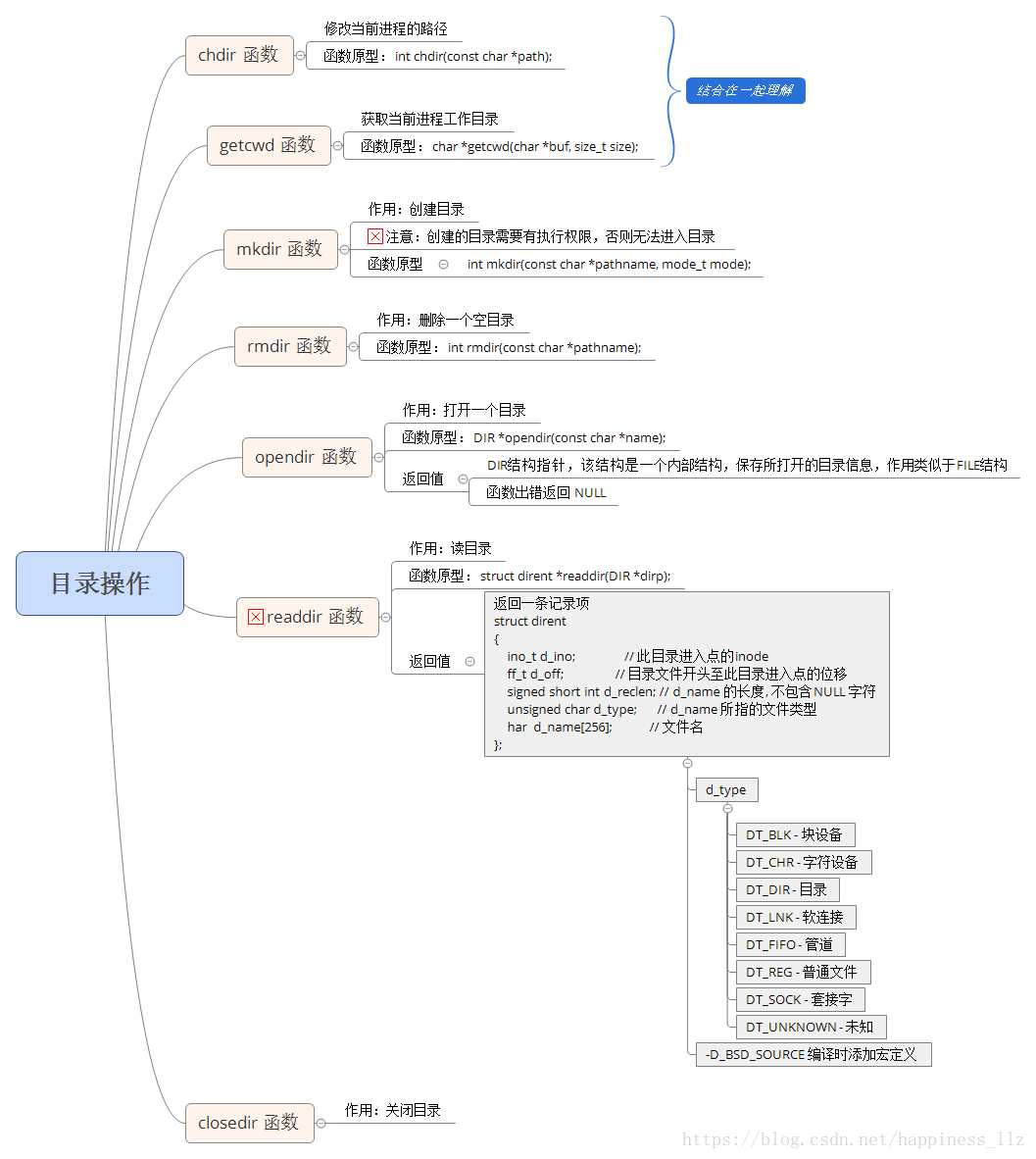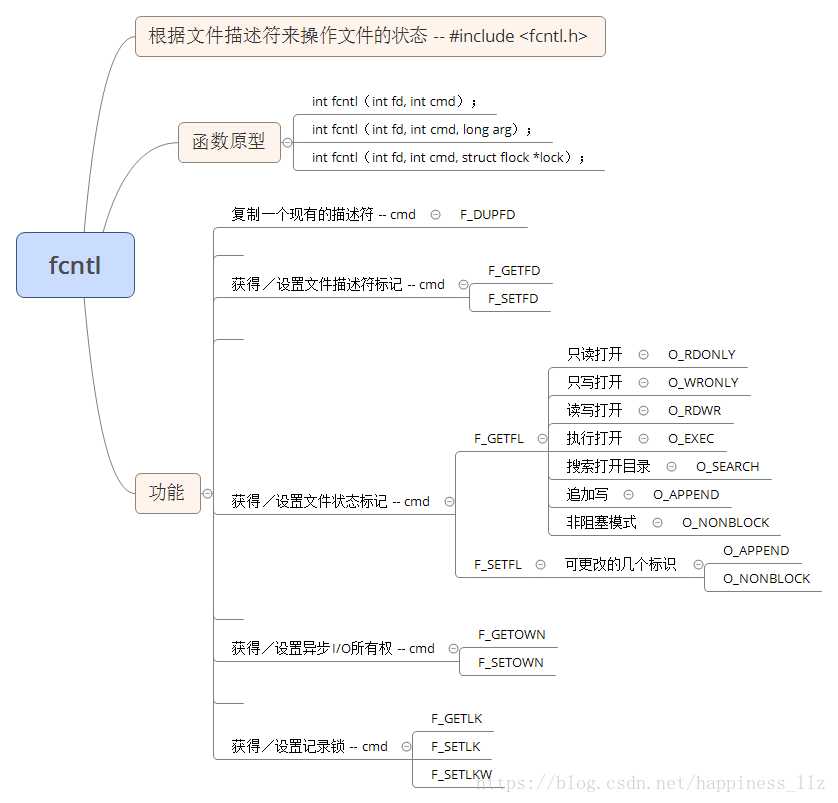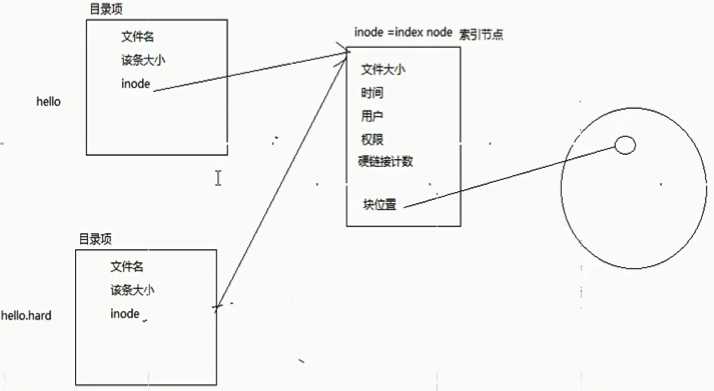标签:linu 动态 margin a.out 直接 循环 amp this font
一、整体大纲

二、相关函数
1. getcwd
#include <unistd.h>
char *getcwd(char *buf, size_t size);
buf传出参数,路径
size缓冲区大小
成功:返回路径的指针
失败:返回NULL
2. chdir
#include <unistd.h>
int chdir(const char *path);
path对应的目标工作路径
成功:返回0
失败:返回-1,设置errno
注意:改变工作路径-注意属于进程独有。
示例:

1 #include<stdio.h> 2 #include<unistd.h> 3 #include<sys/types.h> 4 #include<sys/stat.h> 5 #include<fcntl.h> 6 7 int main(int argc, char *argv[]) 8 { 9 if (argc != 2) 10 { 11 printf("./a.out filename\n"); 12 return -1; 13 } 14 15 //先切换工作目录 16 chdir(argv[1]); 17 18 int fd = open("temp.txt", O_WRONLY|O_CREAT, 0666); 19 write(fd, "daociyiyou", 10); 20 close(fd); 21 22 //获取当前工作目录 23 char buf[256] = {0}; 24 getcwd(buf, sizeof(buf)); 25 printf("buf is %s\n", buf); 26 27 return 0; 28 }
3. mkdir
#include <sys/stat.h>
#include <sys/types.h>
int mkdir(const char *pathname, mode_t mode);
pathname创建的目录路径
mode目录权限 (mode & ~umask & 01777),注意权限,如果目录没有可执行权限,不可进入
成功:返回0
失败:返回-1,设置errno
4. rmdir
5. opendir
#include <sys/types.h>
#include <dirent.h>
DIR *opendir(const char *name);
pathname打开的目录
成功:返回指向该目录流的指针
失败:返回-1,设置errno
6. readdir
#include <dirent.h>
struct dirent *readdir(DIR *dirp);
dirp传入参数,opendir返回的指针
成功:读到目录项的内容
失败:NULL代表读到末尾或者有错误
struct dirent { ino_t d_ino; /* inode number */ off_t d_off; /* not an offset; see NOTES */ unsigned short d_reclen; /* length of this record */ unsigned char d_type; /* type of file; not supported by all file system types */ char d_name[256]; /* filename */ };
7. closedir
#include <sys/types.h>
#include <dirent.h>
int closedir(DIR *dirp);
dirp传入参数,opendir返回的指针
成功:返回0
失败:返回-1,设置errno
需求:统计一下指定目录下的文件个数?

1 #include <stdio.h> 2 #include<unistd.h> 3 #include<dirent.h> 4 #include<string.h> 5 #include <sys/types.h> 6 7 int count = 0; 8 9 int DirCount(char *dirname) 10 { 11 printf("================dirname:%s================\n", dirname); 12 //打开目录 13 DIR *dirp = opendir(dirname); 14 if (NULL == dirp) 15 { 16 perror("opendir err:"); 17 return -1; 18 } 19 //循环读目录,如果是普通文件,count++,如果是目录,继续调用DirCount 20 struct dirent *dentp = NULL; 21 while ((dentp = readdir(dirp)) != NULL) 22 { 23 if (dentp->d_type == DT_DIR) //如果是目录 24 { 25 if (strcmp(dentp->d_name, ".") == 0 || strcmp(dentp->d_name, "..") == 0) 26 { 27 continue; 28 } 29 printf("================dirname:%s, dtype:%d================\n", dentp->d_name, dentp->d_type); 30 //注意进程的工作路径,不能直接打开子目录 31 //使用dirname拼接下一级子目录 32 char newdirname[256] = {0}; 33 sprintf(newdirname, "%s/%s", dirname, dentp->d_name); 34 DirCount(newdirname); 35 } 36 if (dentp->d_type == DT_REG) 37 { 38 count++; 39 printf("-------------filename:%s, dtype:%d------------\n", dentp->d_name, dentp->d_type); 40 } 41 } 42 //关闭目录 43 closedir(dirp); 44 return 0; 45 } 46 47 int main(int argc, char *argv[]) 48 { 49 if (argc != 2) 50 { 51 printf("./a.out dirname\n"); 52 return -1; 53 } 54 DirCount(argv[1]); 55 printf("total file count %d\n", count); 56 57 return 0; 58 }
8. dup2
#include <unistd.h>
int dup2(int oldfd, int newfd);
关闭newfd对应的文件描述符,将newfd重新指向为old对应的文件
成功:返回0
失败:返回-1,设置errno
9. dup
#include <unistd.h>
int dup(int oldfd);
新返回一个文件描述符指向oldfd对应的文件
成功:返回0
失败:返回-1,设置errno
需求:在代码中执行2次printf("hello world\n");一次输出到hello文件,后一次输出到屏幕上?

1 #include <stdio.h> 2 #include<unistd.h> 3 #include<sys/types.h> 4 #include<sys/stat.h> 5 #include<fcntl.h> 6 7 int main(int argc, char *argv[]) 8 { 9 if (argc != 2) 10 { 11 printf("./a.out filename\n"); 12 return -1; 13 } 14 //先备份现场 15 int outfd = dup(1); 16 //先做重定向 17 int fd = open(argv[1], O_WRONLY|O_CREAT, 0666); 18 dup2(fd, 1); 19 printf("Hello world\n"); 20 //必须刷新 21 fflush(stdout); 22 23 //需要回复1,重新对应标准输出 24 dup2(outfd, 1); 25 printf("Hello world\n"); 26 27 close(fd); 28 29 return 0; 30 }
10. errno
#include <string.h>
char *strerror(int errnum);
11. fcntl

三、补充
1. 索引节点inode
保存的其实是实际的数据的一些信息,这些信息称为“元数据”(也就是对文件属性的描述)。例如:文件大小,设备标识符,用户标识符,用户组标识符,文件模式,扩展属性,文件读取或修改的时间戳,链接数量,指向存储该内容的磁盘区块的指针,文件分类等等。( 注意数据分成:元数据+数据本身 )
注意inode怎样生成的:每个inode节点的大小,一般是128字节或256字节。inode节点的总数,在格式化时就给定(现代OS可以动态变化),一般每2KB就设置一个inode。一般文件系统中很少有文件小于2KB的,所以预定按照2KB分,一般inode是用不完的。所以inode在文件系统安装的时候会有一个默认数量,后期会根据实际的需要发生变化。
注意inode号:inode号是唯一的,表示不同的文件。其实在Linux内部的时候,访问文件都是通过inode号来进行的,所谓文件名仅仅是给用户容易使用的。当我们打开一个文件的时候,首先,系统找到这个文件名对应的inode号;然后,通过inode号,得到inode信息,最后,由inode找到文件数据所在的block,现在可以处理文件数据了。
2. inode和文件的关系
当创建一个文件的时候,就给文件分配了一个inode。一个inode只对应一个实际文件,一个文件也会只有一个inode。inodes最大数量就是文件的最大数量。

标签:linu 动态 margin a.out 直接 循环 amp this font
原文地址:https://www.cnblogs.com/xuejiale/p/10790114.html